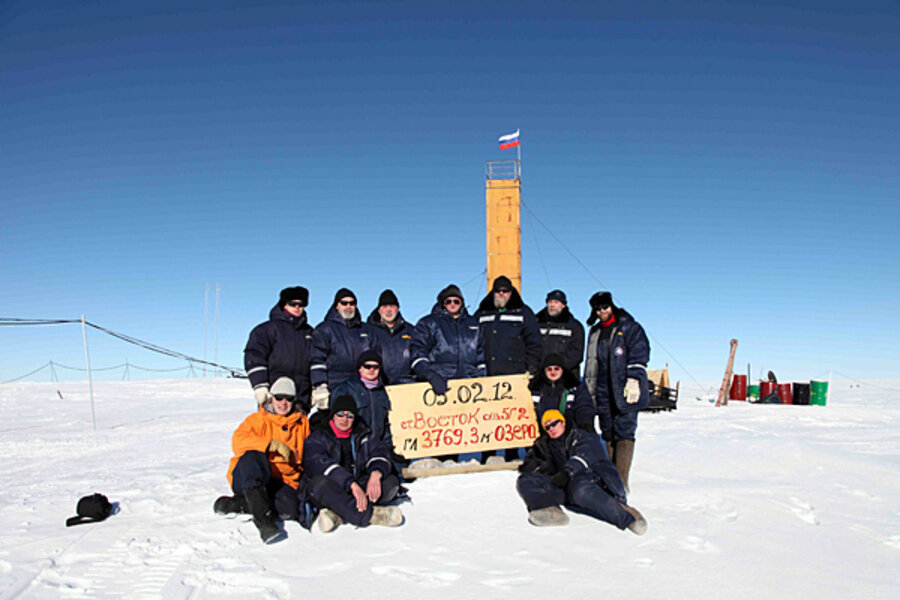Scientists drill past Antarctic ice to reach buried lake. What lies beneath?
Loading...
From high atop an Antarctic ice sheet, Russian scientists appear to have opened a window on the possibility for life forms beneath the icy crusts ... or on Jupiter's moon Europa or on Saturn's moon Enceladus.
This week, researchers at the bottom of the world announced they had drilled through more than 13,000 feet of ice to reach the surface of Lake Vostok – a body of water roughly the size of Lake Ontario. The lake has been capped with ice for the past 15 million to 25 million years.
With this week's development, “we're one step closer to understanding subglacial lakes, and it's a pretty big step,” says Robin Bell, a senior scientist at Columbia University's Lamont-Dougherty Earth Observatory in Palisades, N.Y.
The breakthrough came toward the end of the research season in Antarctica. Scientists anticipate bringing up and analyzing the first samples from the lake next December.
For biologists, finding novel microbes in the lake's frigid water could shed more light on ways organisms adapt to extremely cold, lightless conditions – conditions also thought to exist on Europa and Enceladus.
“There is no other place on Earth that has been in isolation for more then 20 million years. It's a meeting with the unknown,” said Lev Savatyugin, a researcher with Russia's Arctic and Antarctic Research Institute, in an interview with the Associated Press in Moscow.
In addition, core samples pulled from the lake's bottom are expected to contain clues about broad changes in climate that turned the continent from what is thought to have been a thickly forested landscape to a barren, ice-encrusted one known for its record cold temperatures, wind speeds, and dryness.
With Lake Ontario's size, but more than three times its volume, Lake Vostock already has given researchers a better understanding of how ice sheets work, Dr. Bell says.
Studies show how the East Antarctic Ice Sheet, which flows downhill over the top of the lake, gains ice as some of the lake water freezes to the sheet's underside. Bell and colleagues found the same process at work in many other locations across east Antarctica, accounting for as much as half of the ice sheet's thickness in some locations.
Accounting for this hidden process is important to predicting future behavior of ice sheets in a generally warming global climate, the team concluded. Antarctica has at least 300 subglacial lakes.
While Lake Vostok has been covered for millions of years, the water in the lake remains there for an average of about 13,000 years, Bell and colleagues found. Ice at the bottom of the sheet melts under pressure from the sheet's enormous weight, and the water flows into the lake. Meanwhile, some of the lake's water freezes to become part of the underside of the sheet.
For astrobiologists, Lake Vostok may also represent a rough case study of tradeoffs involved in using materials that might contaminate the environment you hope to sample. The Russians reportedly have used an estimated 60 tons of antifreeze and lubricants to keep the drill shaft from freezing on its way to the lake. This raised concerns among some researchers and environmentalists that once the drill bit broke through the ice, the effort risked polluting the surrounding waters. US researchers had suggested using hot water to keep the drill from freezing, but their Russian counterparts noted that they didn't have the energy sources at such a remote site to do the job.
While researchers expected the drill to briefly come in contact with the lake water, they anticipated that the ice sheet's weight would immediately drive water back up the hole, forcing any contaminants back toward the surface.
Indeed, the research team noted that nearly 400 gallons of lubricants and coolant were flushed back into holding tanks when the breakthrough occurred, verifying that lake water had moved up into the shaft before it froze and corked the shaft.
US and British scientists have planned similar projects for lakes under the West Antarctic Ice Sheet.








